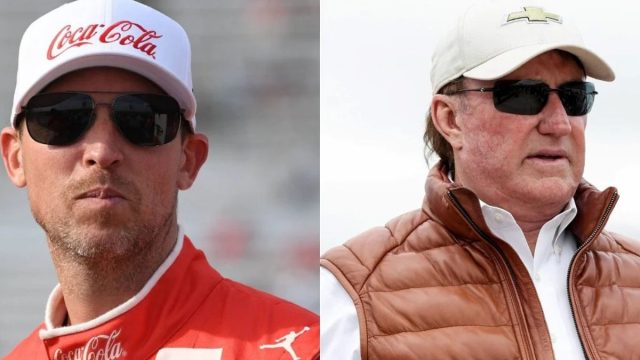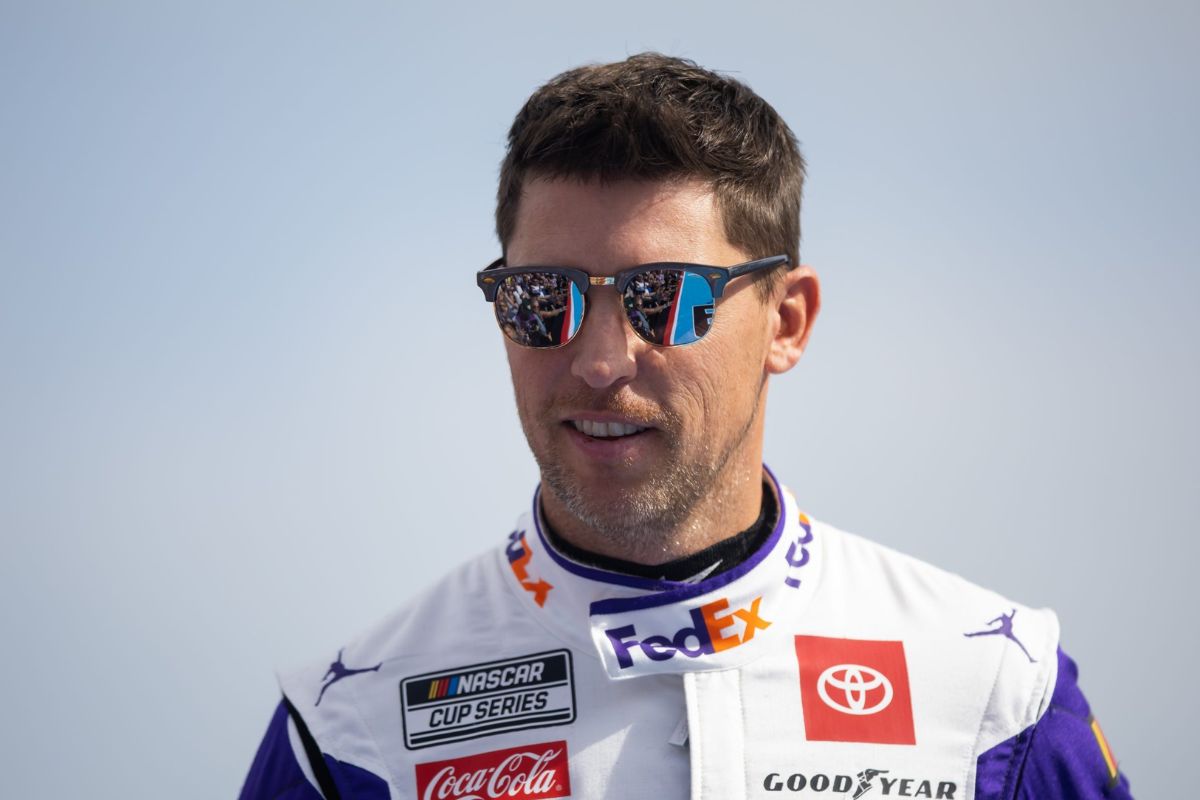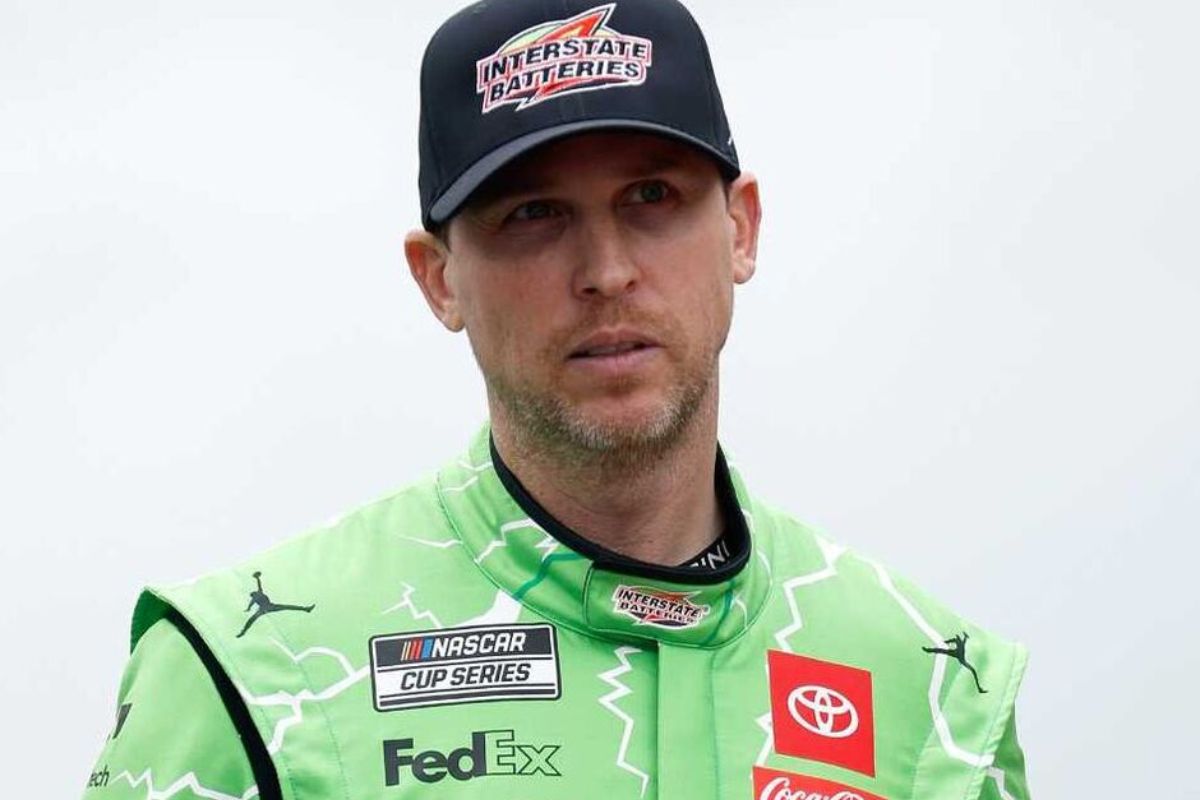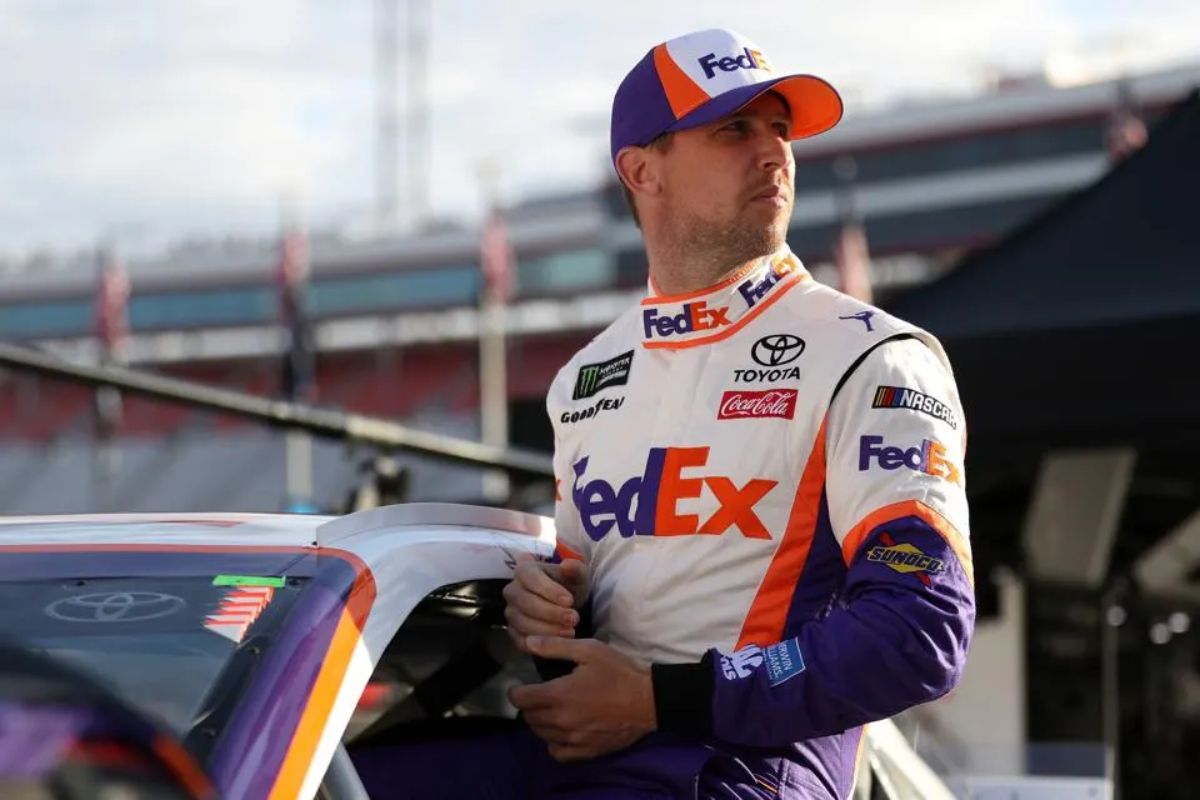Denny Hamlin Blames Richard Childress: In NASCAR racing, Denny Hamlin‘s recent accusation against Richard Childress highlights a critical aspect of motorsport—team strategies and their unforeseen repercussions. During a crucial moment in the race, Hamlin alleged that Childress’ decision to allow Austin Hill to block him effectively cost him a victory. This incident serves not only as a focal point for analyzing the strategic interplay between racing teams but also sets the stage for potential shifts in team dynamics and alliances.
Key Takeaways
- Denny Hamlin attributed his missed win at Kansas Speedway to pit road issues involving Richard Childress’s team.
- Hamlin criticized Austin Hill, a driver for Richard Childress Racing, for lack of consideration during pit stops.
- The proximity issues with Austin Hill caused Hamlin to lose valuable time during critical pit stops.
- Frustrations stemmed from racing ethics and driver responsibilities, impacting Hamlin’s race strategy and outcome.
- Hamlin’s interaction with Childress’s team influenced the race dynamics and his overall performance.
Pit Road Woes for Denny Hamlin at Kansas Speedway
Denny Hamlin’s pursuit for a fourth season victory at Kansas tri-oval track was compromised by a series of pit road setbacks. This unfortunate turn of events not only diluted his momentum but also highlighted the significant influence of pit road performance on race outcomes. Initially, Hamlin demonstrated his driving skills, leading the pack with a substantial edge. However, as the race unfolded, the pit road became a crucial battleground where fractions of seconds had notable implications.
The challenges on pit road are often multifaceted, involving a blend of human precision and mechanical efficiency. For a seasoned driver like Hamlin, any deviation from the ideal pit stop routine can result in lost positions on the track, which are increasingly challenging to recover due to the competitive nature of the field.
Analyzing Hamlin’s performance, it becomes evident that while driver skill is paramount, the support systems surrounding the driver—namely the pit crew’s execution—play an equally important role. The setbacks Hamlin faced likely involved a combination of timing issues, mechanical adjustments, and perhaps strategic missteps. Each pit stop is a mini-event within the larger race, requiring flawless coordination between the driver and his crew.
Pit Road Mishaps
Starting from 14th position, the Pit road mishaps greatly undermined Hamlin’s race strategy, as he lost crucial positions due to errors both personal and from surrounding competitors. Initially, Hamlin overshot his designated pit stall, an error that not only cost him time but also placed him perilously close to Austin Hill. This misjudgment forced Hamlin to navigate in a restricted space, exacerbating the delay as he repositioned his vehicle for service.
Furthermore, Hamlin’s subsequent pit road experience was compromised by Ryan Preece’s difficulty in locating his own pit stall. Preece’s hesitation and eventual slow approach blocked Hamlin, causing an additional, critical loss of time. These sequential pitfalls highlight a broader aspect of race strategy: the necessity for precision and coordination in pit stops. Pit road, often likened to a ballet for its choreographed precision, demands not just driver skill but also acute awareness and synchronization from the crew.
Hamlin’s Frustration
Following the pit road mishaps, Hamlin’s frustration was palpable as he publicly criticized Austin Hill and his team for their lack of consideration during the race. His remarks, aired on his podcast, highlight the tensions that can arise when competitive objectives clash on the track. Hamlin, a seasoned driver contending for the lead, expected a level of track etiquette that he felt Hill, as the last car on the lead lap, failed to uphold.
“He [Austin Hill] was last. He was the last car on the lead lap. He wasn’t going to gain anything. And I’m leading the race and they boxed me in and I’m like, it wasn’t very courteous for sure, but it’s like, it seems I don’t know why. I thought it would just be common sense for driver spotter and crew chief to if someone is racing for the lead, don’t you know, and you are racing for nothing. You are last, you’re the last car. Let the guy leave before you know if it’s going to be close.” hamlin said.
Hamlin’s critique goes beyond mere race-day irritations, tapping into broader questions about racing ethics and the responsibilities of drivers in varying positions. His argument is that Hill, albeit legally in the race, should have exercised greater awareness of the leaders’ battle, which could have influenced the race’s outcome.
Moreover, Hamlin’s vocal disappointment is indicative of the pressures drivers face in such environments. It reveals how crucial moments, especially those involving potential race wins, heighten expectations for conduct and strategy among drivers. Hamlin’s reaction also serves as a strategic move to perhaps influence future interactions on the track, setting a precedent for how he believes lead-lap drivers should be treated by those they lap.
Race Developments and Overtime Chaos
As the race neared its climax, a strategic decision by Hamlin’s crew chief to equip the car with two fresh tires set the stage for a crucial finish. This choice, critical in the heat of the competition, was aimed at giving Hamlin a vital edge over Martin Truex Jr., who had been a consistent threat throughout the race. The move by Chris Gabehart, Hamlin’s crew chief, was a calculated risk, balancing the benefits of fresh rubber against the potential loss of track position.
The drama intensified when a caution flag was waved due to an incident involving Kyle Busch, their former teammate. This caution changed the dynamics of the race, compressing the field and setting up what would become a frenetic dash to the finish. The decision to go with two tires was a tactical one, predicated on the assumption that track position and a short sprint to the finish would outweigh the advantage of four fresh tires in relation to grip and speed.
“Well, a difficult spot, right? I needed to get the push from [Larson], but I knew he wasn’t going to stay in line, that he was going to go for the win. Unfortunately, it left me in a spot where I was vulnerable in the middle.”- hamlin
As the green flag waved for the overtime period, the tension was palpable. The drivers were now in a environment where every decision and every moment on the track could drastically alter the outcome. Hamlin, with his partially refreshed vehicle, was in a prime position to capitalize. However, the chaos of overtime racing, where strategies and fortunes can shift instantaneously, meant that the advantage could swing wildly.
Disappointing Finish and Looking Ahead
Despite a well-strategized race, Denny Hamlin’s efforts culminated in a fifth-place finish, leaving him and his team to ponder their strategy for the upcoming Darlington Raceway event. The disappointment was palpable, as Hamlin had been a strong contender throughout the race. The final laps, however, exposed vulnerabilities in both his approach and position, compelling a shift in tactics as he prepares for one of the circuits he favors.
Analyzing Hamlin’s performance, several critical elements emerge. Firstly, his ability to navigate the pack and maintain a leading position was undermined by the late-race dynamics, particularly the three-wide squeeze orchestrated by Kyle Larson.
Looking ahead, the focus for Hamlin and his team shifts to leveraging his historical success at Darlington. Known for his aptitude on such tracks, Hamlin’s approach will likely emphasize precision driving and pit strategy. The upcoming race presents an opportunity to refine these tactics, capitalizing on his familiarity with the track’s unique demands.
News in Brief: Denny Hamlin Blames Richard Childress
The incident at Kansas Speedway serves as a powerful example of the intricate interplay between team strategies and individual aspirations in NASCAR. Denny Hamlin’s grievance against Richard Childress highlights the heightened rivalries and strategic blocking that often influence race outcomes.
As competitors navigate these dynamics, the importance of sportsmanship and strategic expertise becomes apparent. Moving forward, the incident may prompt closer scrutiny of team tactics and their implications for race integrity and relationships within the sport.
Our Reader’s Queries
Q. What did Denny Hamlin do at Richmond?
A. In a thrilling turn of events during the NASCAR Cup Series race at Richmond, a late-race pass unfolded on Sunday, sparked by dramatic driver-to-driver contact. With tension mounting and less than two laps remaining, Bubba Wallace and Kyle Larson found themselves entangled on the track. However, it was Denny Hamlin, positioned third at the time, who seized the opportunity, surging ahead of Martin Truex Jr. to claim the lead with a strategic maneuver on pit road.
Q. Did Denny Hamlin get penalized at Richmond?
A. Addressing the controversy surrounding the final restart, Sawyer emphasized on Tuesday that there was no ambiguity: “(Hamlin) rolled early.” Despite this assertion, NASCAR’s review following Sunday night’s race concluded without a penalty issued. This decision allowed Denny Hamlin to maintain his victory in the race, leaving fans and pundits to ponder the implications of the non-call in the aftermath of the event.
ALSO READ: Denny Hamlin Reveals X-Factor Behind Struggles In Cup Series



